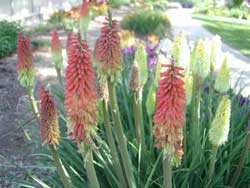Resource Library
Plant of the Week: Red Hot Poker
The University of Arkansas System Division of Agriculture does not promote, support or recommend plants featured in "Plant of the Week." Please consult your local Extension office for plants suitable for your region.
Plant of the Week
[A-Z]
Red Hot Poker
Latin: Kniphofia uvaria

Plants come and go in our gardens. A plant I like, but for the moment is missing from my garden, is red hot poker (Kniphofia uvaria). I like the plant - it should do well in my garden and it’s bright orange - so I must get one.
About 70 species of Kniphofias are found in Africa with most of the cultivated selections coming from South Africa. They belong to Asphodelaceae family, a new family split from the overly large lily family.
Red hot pokers are closely related to aloes except Kniphofias don’t have very succulent leaves. The leaves are linear, v-shaped and are about 30 inches long with a rough-textured margin. They arise from a crown of fleshy roots. In mild winters, the leaves may be semi-evergreen.
In late spring and early summer, 3-foot to 4-oot-tall scapes emerge bearing a terminal, bottlebrush shaped cluster of orange, red, yellow or cream colored blooms. Usually, the top of the inflorescence will be orange or red while the older flowers at the base will have faded to yellow or cream. Plants remain in bloom for about a month.
Studying plants, learning about them and classifying them has been practiced for at least as long as written language has been recorded. Through the millennia, the systems of classification have changed dramatically as more and more plants were discovered and a broader perspective of relationships became available.
Since the 18th century naming and classification has stabilized - at least to a degree - as botanists adopted the principles of the Linnaean system for naming and the Jussieuan system for classification which takes into account all of the physical features of a plant before assessing relationships.
Then DNA was discovered. As everyone knows who watches the latest batch of TV crime shows, DNA is the most accurate way of assessing relationship. Since the 1980s, scientists have been amassing a wealth of DNA data on plants, particularly looking at two genes on the plant’s chloroplast and one from its ribosome.
By using the DNA results, new classification schemes have been developed, which are based on the ancient evolutionary ancestry of various species. Plants with similar DNA profiles must be more closely related than plants with dissimilar profiles. And, because the rate of mutations for genes is believed to be constant, an ancestral family tree can be worked out by looking at the relative mutation rate.
This new classification system is called the APG II system. In the old days before the Internet, plant classification schemes were worked out by one or two scientists working alone in their musty labs. The APG II system relies on a committee approach with 30 or more institutions around the world conferring and providing the most up to date information.
The APG II system looks almost exclusively at DNA and largely ignores the physical attributes of the plants being classified. The APG group is primarily focused on the higher levels of classification above the plant family. The system is still new and has not been universally accepted, but it seems to be gaining momentum.
Red hot pokers should be grown in sunny locations with well drained soils. K. uvaria is the progenitor of most of the garden forms. It comes from an area of South Africa where it rains during the winter but too much moisture in the winter or planting in too heavy a soil will lead to root rot. Plants are hardy to zone 5 but are more likely to survive long term in areas with somewhat milder winters. If planted in a good site, clumps continue to expand and can reach 3 feet across.
New plants can be easily raised from seed with flowers usually produced in the second season. Division of older clumps can be done but should be delayed until the spring just before new growth starts.
By: Gerald Klingaman, retired
Extension Horticulturist - Ornamentals
Extension News - September 19, 2008
The University of Arkansas System Division of Agriculture does not maintain lists of retail outlets where these plants can be purchased. Please check your local nursery or other retail outlets to ask about the availability of these plants for your growing area.